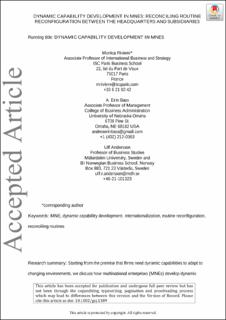Dynamic capability development in multinational enterprises: Reconciling routine reconfiguration between the headquarters and subsidiaries
| dc.contributor.author | Riviere, Monica | |
| dc.contributor.author | Bass, A. Erin | |
| dc.contributor.author | Andersson, Ulf | |
| dc.date.accessioned | 2023-04-25T11:59:33Z | |
| dc.date.available | 2023-04-25T11:59:33Z | |
| dc.date.created | 2021-02-09T16:02:47Z | |
| dc.date.issued | 2020 | |
| dc.identifier.citation | Global Strategy Journal. 2020, . | en_US |
| dc.identifier.issn | 2042-5791 | |
| dc.identifier.uri | https://hdl.handle.net/11250/3064945 | |
| dc.description.abstract | Starting from the premise that firms need dynamic capabilities to adapt to changing environments, we discuss how multinational enterprises (MNEs) develop dynamic capabilities from internationalization. Unlike domestic firms that develop dynamic capabilities within one organizational system, MNEs are inherently multi‐level systems with the headquarters and subsidiaries. In this paper, we focus on how internationalization depth and breadth function as sources of learning and unlearning in the headquarters and subsidiaries, and how this serves as the antecedent for routine reconfiguration and dynamic capability development in the MNE. We theorize that the headquarters' and subsidiaries' brokering capabilities are critical for reconciling routine reconfiguration at the two levels so that dynamic capability development can occur, and the MNE can adapt to environmental changes. | en_US |
| dc.language.iso | eng | en_US |
| dc.publisher | Wiley | en_US |
| dc.title | Dynamic capability development in multinational enterprises: Reconciling routine reconfiguration between the headquarters and subsidiaries | en_US |
| dc.type | Journal article | en_US |
| dc.type | Peer reviewed | en_US |
| dc.description.version | acceptedVersion | en_US |
| dc.source.pagenumber | 380-401 | en_US |
| dc.source.volume | 11 | en_US |
| dc.source.journal | Global Strategy Journal | en_US |
| dc.source.issue | 3 | en_US |
| dc.identifier.doi | 10.1002/gsj.1389 | |
| dc.identifier.cristin | 1888203 | |
| cristin.ispublished | true | |
| cristin.fulltext | postprint | |
| cristin.qualitycode | 1 |
